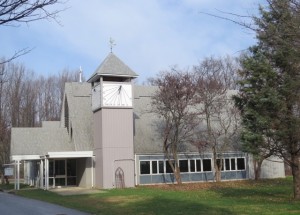
The refurbished church tower now has an angled roof (instead of the former flat roof), surmounted by an old-fashioned weathercock. Behind it, you can see the new Celtic cross at the west end of the nave.
They served as places of shelter in times of war. When enemies came to rob and pillage, congregations simply barricaded themselves in the tower. Similarly, church bells were used both as a call to worship and a means of summoning help in times of war and civil emergencies. In times of peace and tranquility, church towers continued to serve practical purposes. Time is an age-old human preoccupation, and in the days before wrist watches were invented, they looked towards the church towers for answers.
Since the Dark Ages, church towers have been decorated with sun dials. Often they were very elaborate affairs, embellished not only with gilded scrollwork, but also with proverbs and religious texts.
They were a favorite memorial gift among the local gentry because the name of the donor was constantly brought to mind. The clergy favored them because they provided the flocks with a perpetual sermon on the shortness of life and the need to repent before it was too late.
Sundials did not fare well during the Parliamentary Rebellion of the 17th century. The puritan soldiers all-too-frequently smashed elaborately decorated sundials claiming they fostered idolatry.
Many of the sundials that survived this ugly period of English history were destroyed by the arrival of the church clock. In the Middle Ages, only wealthy cathedrals and abbeys could afford clocks, but from the 17th century onwards, parish clocks increasingly displaced the sun dial.
Even so, many ancient sun dials still occupy places of honor on church buildings. There is a breathtaking example at Hampton Court Palace and notable ones at Oxford, Cambridge and, of course, St. Stephen’s Church, Timonium.


